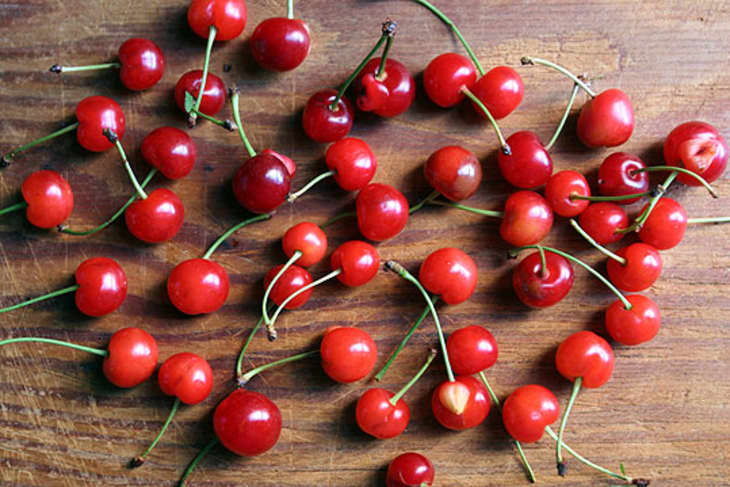The Best Way to Buy, Store, and Use Fresh Cherries, According to an Expert
Since cherries come in a number of different forms with range of flavors and attributes, they’re a pretty versatile ingredient. Jarred cherries are great for garnishing ice cream sundaes or a cocktail like a Manhattan while fresh or frozen cherries make for wonderful desserts like pies, crumbles, crisps, and more.
When shopping for stone fruit like fresh cherries, though, there are a few simple steps you should take to make sure that you’re tracking down the best cherries possible as well as handling them properly once you take them home. Storing cherries the right way is just as important as storing fruit like strawberries or fresh herbs like cilantro. Plus, knowing how to store your produce correctly is the best way to make sure it lasts the longest and maintain their fresh taste.
Types of Cherries
The two main categories for cherries are sweet and sour. As you might assume, sweet cherries have a rich sweet taste to them while sour cherries have a relatively tart flavor, which is sometimes balanced out with the use of sugar or some sort of sweetener in baking recipes. A few different varieties of sweet cherries include Bing, Rainier, Chelan, Lapin and Tulare. Sweet cherries are the ones you’re more likely to come across at the store or market. Types of sour cherries include English Morello, Montmorency, and Early Richmond. While most cherries are a shade of red, you can find cherries that range from a red-burgundy color to ones with reddish-yellow hues.
The large majority of cherries you find in a produce section during the summer are grown in the Pacific Northwest.”In grocery stores, you’re almost certain to find sweet cherries,” says James W. Michael, vice president of marketing for Northwest Cherry Growers & Washington State Fruit Commission. “Those are what people think of when they’re picturing a bowl of cherries.” Tart cherries, on the other hand, can sometimes be purchased at local farmer’s markets, though they’re generally less commonly sold in stores compared to sweet cherries.
How to Buy Fresh Cherries
When it comes to looking for the common red cherry, depth of color is more important than the particular shade of red. Look for fruits with deep, dark saturation. Additionally, you’ll want to pay close attention to the stems of the cherries. “Not all stems behave the same on all varieties,” says Michael. “But a good rule of judgement is the brighter green and more flexible the stem, the more recently that cherry was harvested.” A lack of stem on a cherry, however, doesn’t necessarily mean the cherries are low quality, they just aren’t the freshest in the bunch. Red cherries should also be firm. Wrinkling along the shoulders near the stem means the cherries have sat at room temperature; they may still be sweet, but are probably not at peak freshness.
Many people think reddish-yellow cherries, like Rainier cherries, are underripe, but this is their natural color. They are also naturally less firm than red cherries. A red or pink blush indicates sun exposure, which leads to sugar accumulation. Brown flecks are generally not defects but a further indicator of sugar accumulation. (Red cherries have this, too, but it’s less visible.)
Aside from visual cues, another great way to pick out the best cherries at the grocery store or farmers market is to taste one. If your farmers market vendor or grocery store provides samples, definitely give one a try. If you’re not able to taste cherries before purchasing them, however, follow the guidelines above to make sure you’re getting a good batch.
How to Store Fresh Cherries
It’s all about temperature when it comes to properly storing fresh cherries. “The most important thing in preserving cherry quality is keeping them cold,” says Michael. “The best tip is to buy cherries from a retailer that keeps them in a refrigerated display or rotates them frequently.” Cherries can lose quality rapidly at room temperature, so it’s crucial that you put cherries in the refrigerator immediately. To store cherries, Michael recommends putting them in a wide bowl that fits comfortably in your refrigerator. If you plan on eating them very soon after buying them (within about 3 to 4 days), you can rinse them off with cold water and thoroughly pat them dry with paper towels to avoid excess moisture and spoilage. Once cleaned and dried, you can snack on these cherries throughout the week.
If you plan on keeping your cherries in the refrigerator for a more extended amount of time, only wash them with cold water just before you plan on eating or cooking with them. Cherries can also be frozen. Pit them if you wish, or keep them whole with stems intact. Spread them in a single layer on a baking sheet, freeze until firm, and then place in a bag or container.
How to Use Fresh Cherries
While fresh cherries are always great on their own, they’re even better when you use them in a tasty dish. Cherries, both sweet and sour, typically work well in baked goods, such as pies, tarts, and galettes. Additionally, cherries can often be used to make a sweet topping for a dessert or even a syrup for a drink. Try some of our best cherry recipes make the most of this lovely summer fruit.
